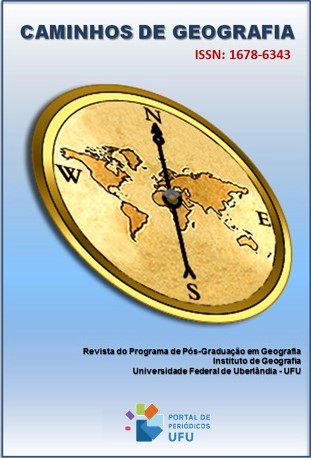PLANOS DIRETORES E O CONTEXTO REGIONAL: EVIDÊNCIAS A PARTIR DOS DEZ MUNICÍPIOS MAIS POPULOSOS DE MINAS GERAIS
DOI:
https://doi.org/10.14393/RCG249161820Palavras-chave:
Planejamento Urbano, Região, Indicadores sociais, Município, Índice Mineiro de Responsabilidade Social (IMRS)Resumo
Este estudo parte da inquietação causada pela ausência de conteúdos regionais nos Planos Diretores de grande parte dos municípios mineiros. Visando a ilustrar a extensão dessas omissões, realizou-se uma análise dos Planos Diretores dos dez municípios mais populosos de Minas Gerais. Concomitantemente, analisaram-se os principais manuais de construção de Planos Diretores, nos quais a presença de dimensões e indicadores que deveriam compor a construção de diagnósticos municipais foi identificada, com destaque para a capacidade institucional; cultura; desenvolvimento econômico; desenvolvimento social; dinâmica imobiliária; estrutura fundiária; evolução histórica da cidade/município; infraestrutura urbana; meio ambiente; população (mobilidade e circulação); saneamento; e uso do solo. Partindo da necessidade de incorporação do contexto regional dos municípios à construção dos Planos Diretores, este estudo analisa o potencial de utilização dos dados disponibilizados pelo Índice Mineiro de Responsabilidade Social (IMRS) na caracterização do contexto regional dos municípios mineiros, oferecendo uma cesta de indicadores produzidos e disponibilizados gratuitamente pela Fundação João Pinheiro. A adoção desses indicadores e o foco na perspectiva regional ampliarão sensivelmente o poder dos Planos Diretores, fazendo cumprir de modo mais assertivo os pressupostos presentes no Estatuto das Cidades.
Downloads
Downloads
Publicado
Edição
Seção
Licença
Copyright (c) 2023 Alexandre Magno Alves Diniz

Este trabalho está licenciado sob uma licença Creative Commons Attribution-NonCommercial-NoDerivatives 4.0 International License.
Autores que publicam nesta revista concordam com os seguintes termos: a) Autores mantém os direitos autorais e concedem à revista o direito de primeira publicação, com o trabalho licenciado sob a Creative Commons Atribuição-NãoComercial-SemDerivações 4.0 Internacional. b) Autores têm permissão e são estimulados a publicar e distribuir seu trabalho online (ex.: em repositórios institucionais ou na sua página pessoal), já que isso pode gerar alterações produtivas, bem como aumentar o impacto e a citação do trabalho publicado. c) Em virtude de aparecerem nesta revista de acesso público, os artigos são de uso gratuito, com atribuições próprias, em aplicações educacionais e não-comerciais.











